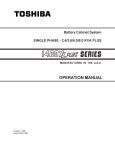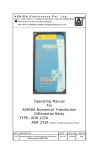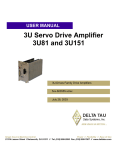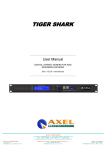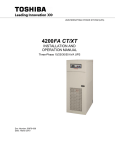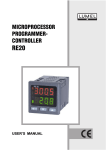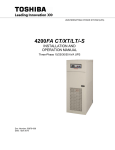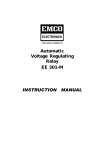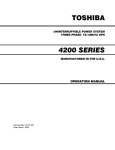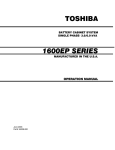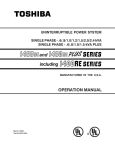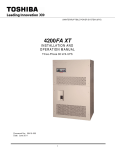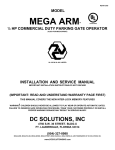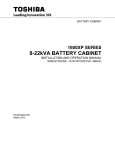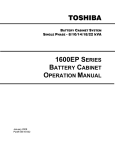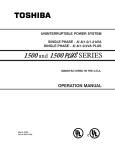Download caution
Transcript
UNINTERRUPTIBLE POWER SYSTEM SINGLE PHASE - 2.4/3.6/6.0/8.0 kVA PLUS OPERATION MANUAL July, 2003 Part # 43535-005 TOSHIBA NOTE The instructions contained in this manual are not intended to cover all of the details or variations in equipment, nor to provide for every possible contingency to be met in connection with installation, operation, or maintenance. Should further information be desired or should particular problems arise which are not covered sufficiently for the purchaser's purposes, the matter should be referred to the local Toshiba sales office. The contents of this instruction manual shall not become a part of or modify any prior or existing agreement, commitment, or relationship. The sales contract contains the entire obligation of Toshiba International Corporation's UPS Division. The warranty contained in the contract between the parties is the sole warranty of Toshiba International Corporation's UPS Division and any statements contained herein do not create new warranties or modify the existing warranty. Any electrical or mechanical modifications to this equipment, without prior written consent of Toshiba International Corporation, will void all warranties and may void UL/CUL listing. Unauthorized modifications also can result in personal injury, death, or destruction of the equipment. UNINTERRUPTIBLE POWER SUPPLY If additional information or technical assistance is required call Toshiba's marketing department toll free at (800) 231-1412 or write to: Toshiba International Corporation, 13131 W. Little York Road, Houston, TX 77041-9990. Please complete the following information for your records and to remain within this equipment manual: Model Number: Serial Number: Date of Installation: Inspected By: i TOSHIBA CONTENTS SECTION PAGE Disclaimer ................................................................................................. i Contents ................................................................................................. ii-iii Introduction ............................................................................................. iv General Safety Instructions.................................................................... v Important Safety Instructions ..............................................................vi-vii 1.0 Product Description ............................................................................... 1-1 1.1 Theory of Operation ........................................................................ 1-1 1.2 Application and Use ....................................................................... 1-1 1.3 Power Backup ................................................................................. 1-1 1.4 Power Conditioning ........................................................................ 1-1 2.0 Inspection/Storage/Disposal................................................................. 2-1 2.1 Inspection of the new UPS equipment ........................................... 2-1 2.2 Storage of UPS equipment ............................................................. 2-1 2.3 Disposal .......................................................................................... 2-1 3.0 Precautions ............................................................................................ 3-1 3.1 Installation Precautions ................................................................... 3-1 3.2 Prestart Precautions ........................................................................ 3-1 3.3 Operating Precautions .................................................................... 3-1 4.0 UPS 4.1 4.2 4.3 4.4 5.0 Specifications ......................................................................................... 5-1 5.1 XL Plus Series Specifications ......................................................... 5-1 6.0 Operating the UPS ................................................................................. 6-1 6.1 Initial Battery Charge....................................................................... 6-1 6.2 Start-up Procedure .......................................................................... 6-1 Connections ................................................................................... 4-1 Power Connections ......................................................................... 4-1 Terminal Block Details .................................................................... 4-1 Wire Size and Tightening Torque ................................................... 4-2 Communication Interface ................................................................ 4-2 4.4.1 Remote Contact (IBM AS/400) ............................................... 4-2 4.4.2 RS-232C ................................................................................. 4-3 4.4.3 UPS Shutdown (via RS-232C) ............................................... 4-3 ii TOSHIBA CONTENTS (Cont'd) SECTION PAGE 6.0 Operating the UPS (Cont'd) .................................................................. 6-1 6.3 Battery Check Function ................................................................... 6-1 6.4 Shutdown Procedure ...................................................................... 6-2 6.5 Restart Procedure ........................................................................... 6-2 6.5.1 Restart After Non-Fatal Fault .................................................. 6-2 6.5.2 Restart After Fatal Fault .......................................................... 6-2 6.6 Battery Backup Time and Discharge Process ................................ 6-3 6.7 Battery Low Voltage Tolerances ..................................................... 6-3 6.8 Battery Recharging ......................................................................... 6-4 6.9 Operation Modes ............................................................................ 6-5 6.9.1 AC Input Mode (normal operation)......................................... 6-5 6.9.2 Circuit Bypass Mode .............................................................. 6-5 6.9.3 Battery Backup Mode............................................................. 6-6 6.10 Audible Alarm Functions ................................................................. 6-6 6.11 EPO (Emergency Power Off) Function ............................................ 6-7 6.12 System Protection Features ............................................................ 6-7 6.13 Front Panel Layout ......................................................................... 6-8 6.13.1 Front Panel Indicator LED Lamps ....................................... 6-8 6.13.2 Front Panel Indicator LED Functions ................................... 6-8 6.13.3 Front Panel Buzzer Reset .................................................... 6-9 6.14 UPS Run Mode Display .................................................................. 6-9 7.0 Troubleshooting Procedures ................................................................ 7-1 7.1 Non-Fatal Fault Mode ..................................................................... 7-1 7.2 Fatal Fault Mode ............................................................................. 7-2 8.0 Preventive Maintenance/Parts Replacement ........................................ 8-1 8.1 Preventive Maintenance.................................................................. 8-1 8.2 Parts Replacement ......................................................................... 8-1 9.0 External Layouts/Dimensions/Shipping Weights ................................ 9-1 9.1 External Layouts (hardwired units) ................................................. 9-1 9.2 Dimensions . 9-2 9.3 Shipping Weights ........................................................................... 9-2 iii TOSHIBA INTRODUCTION Thank you for purchasing the 1400XL Plus Series UPS. This Series features the very latest state of the art microprocessor technology and IGBT transistors for fast, high power and low noise PWM (pulse width modulation) switching. The Plus Series features a low impedance output transformer to provide total power conditioning and noise isolation even during bypass operation. It is the intent of this manual to provide a guide for installing, operating, and maintaining the UPS. Please read this manual thoroughly before installation and operation. All warnings and precautions should be observed for both personal safety and for proper equipment performance and longevity. Read the important safety instructions on page v and vi. Save these safety instructions for future reference. This manual is divided into major sections of interest. Product description and application information can be found in Section 1. Sections 2 and 3 contain information about initial inspection, storage, installation and operating precautions. Section 4 contains information about the equipment's electrical connections and communication interfaces. The equipment specifications are located in Section 5. Section 6 outlines the start-up, shutdown and restart procedures and explains operating modes, protective features, battery recharging, battery low voltage tolerances, alarm and panel indicator functions. Section 7 is devoted to troubleshooting procedures utilizing the fault mode display. Section 8 should be reviewed before scheduling preventive maintenance and/or periodic parts replacement. Section 9 shows front, rear, and side panel layout views. Connectors, switches, dimensional data and shipping weights are also shown. Finally, we hope that you find this manual informative and easy to understand. Once again thank you for the purchase of this product. TOSHIBA INTERNATIONAL CORPORATION © Copyright 1994 iv TOSHIBA GENERAL SAFETY INSTRUCTIONS Warnings in this manual appear in either of three ways: 1) Danger warnings - The danger warning symbol is an exclamation mark enclosed in a triangle which precedes the 3/16" high letters spelling the word "DANGER". The Danger warning symbol is used to indicate situations, locations, and conditions that exist and can cause serious injury or death: DANGER 2) Caution warnings - The caution warning symbol is an exclamation mark enclosed in a triangle which precedes the 3/16" high letters spelling the word "CAUTION". The Caution warning symbol is used to indicate situations and conditions that can cause operator injury and/or equipment damage: CAUTION 3) Attention warnings - The attention warning symbol is an exclamation mark enclosed in a triangle which precedes the 3/16" high letters spelling the word "ATTENTION". The Attention warning symbol is used to indicate situations and conditions that can cause operator injury and/or equipment damage: ATTENTION Other warning symbols may appear along with the Danger and Caution symbol and are used to specify special hazards. These warnings describe particular areas where special care and/or procedures are required in order to prevent serious injury and possible death: 1) Electrical warnings - The electrical warning symbol is a lighting bolt mark enclosed in a triangle. The Electrical warning symbol is used to indicate high voltage locations and conditions that may cause serious injury or death if the proper precautions are not observed: 2) Explosion warnings - The explosion warning symbol is an explosion mark enclosed in a triangle. The Explosion warning symbol is used to indicate locations and conditions where molten, exploding parts may cause serious injury or death if the proper precautions are not observed: v TOSHIBA IMPORTANT SAFETY INSTRUCTIONS This manual contains important instructions SAVE THESE INSTRUCTIONS for 2.4, 3.6, 6.0, and 8.0 kVA units that should be followed during the installation and use of the UPS and it's batteries. Hardwire type UPS units are not equipped with an overcurrent-protection device, nor an output disconnect for the ac output. Therefore, a circuit breaker should be provided by the user between the UPS output and the load input. This device should be rated as follows: 2.4 kVA: 220 or 240/208 Vac, 15A 3.6 kVA: 220 or 240/208 Vac, 20A 6 kVA: 220 or 240/208 Vac, 30A 8 kVA 240/208 Vac, 40A The maximum ambient temperatures in which the UPS units should be operated are as follows: 2.4 kVA: 104° F (40° C). 3.6 kVA: 104° F (40° C). 6 kVA: 104° F (40° C). 8 kVA 104° F (40° C). The nominal battery voltages for these models are as follows: 2.4kVA: 96Vdc 3.6kVA: 144Vdc 6 kVA: 216Vdc 8 kVA 252Vdc Servicing of the batteries should only be performed by a qualified Toshiba Representative who is knowledgeable of batteries and the required precautions. Keep unauthorized personnel away from batteries. When having batteries replaced, use the same number and type of one of the following sealed, lead-acid batteries: Model Capacity Manufacturer Type Quantity 2.4 kVA Panasonic Yuasa LCV 12V-7.2P NP7-12FR 8 8 3.6 kVA Panasonic Yuasa LCV 12V-7.2P NP7-12FR 12 12 6 kVA Panasonic Yuasa LCV 12V-7.2P NP7-12FR 18 18 8 kVA Panasonic Yuasa LCV 12V-7.2P NP7-12FR NPX-35FR (9Ah) 21 21 21 Misuse of this equipment could result in human injury and equipment damage. In no event will Toshiba Corporation be responsible or liable for either indirect or consequential damage or injury that may result from theuse of this equipment. CAUTION CAUTION Do not dispose of the batteries in a fire. The batteries may explode. This unit contains sealed lead acid batteries. Lack of preventative maintenance could result in batteries exploding and emitting gasses and/or flame. Annual preventative maintenance must be performed by an authorized, trained technician. WARNING WARNING Failure to replace a battery before it becomes exhausted may cause the case to crack, possibly releasing electrolytes from inside the battery, and resulting in secondary faults such as odor, smoke, and fire. vi TOSHIBA WARNING Installation and servicing of batteries should be performed by personnel knowledgeable of batteries and the required precautions. Keep unauthorized personnel away from the batteries. Proper maintenance to the battery system of this unit must be done by a qualified service techincian, this is essential to the safety and reliability of your UPS system. Refer to service manual. WARNING DANGER A battery can present a risk of electrical shock and high short circuit current. The following precautions should be observed when working with batteries: 1) Verify that the UPS is off and that the power cord is disconnected from the power source. 2) Remove watches, rings or other metal objects. 3) Use tools with insulated handles to prevent inadvertent shorts. 4) Wear rubber gloves and boots. 5) Do not lay tools or metal parts on top of batteries. 6) Determine if the battery is inadvertently grounded. If inadvertently grounded, remove source of ground. Contact with any of a grounded battery can result in elecrtical shock. The likelihood of such shock will be reduced if such grounds are removed during installation and maintenance. 7) Verify circuit polarities prior to making connections. 8) Disconnect charging source and load proir to connecting or diconnecting terminals. 9) VRLA batteries contain an explosive mixture of hydrogen gas. Do not smoke, cause a flame or spark in the immediate area of the batteries. This includes static electricity from the body. 10) Do not attempt to open the batteries in order to add water or sample the specific gravity of the electrolyte. The batteries are valve requlated lead acid type and such servicing is not possible without damaging the battery. 11) Use proper lifting means when moving batteries and wear all appropriate safety clothing and equipment. 12) Do not dispose of lead acid batteries except through channels in accordance with local, state and federal regulations. INSTRUCTIONS IMPORTANTES CONCERNANT LA SÉCURITÉ Cette notice contient des instructions CONSERVER CES INSTRUCTIONS importantes concernant la sécurité. Une battery peut présenter un risque de choc électrique, de brûlure par ATTENTION transfert d' énergie. le remplacement, utiliser le même nombre de batteries du modéle ATTENTION Pour suivant. Model Capacity Manufacturer Type Quantity 2.4 kVA Panasonic LCV 12V-7.2P 8 Yuasa NP7-12 8 Panasonic LCV 12V-7.2P 12 Yuasa NP7-12 12 Panasonic LCV 12V-7.2P 18 Yuasa NP7-12 18 Panasonic LCV 12V-7.2P NPX-35FR (9Ah) 21 21 3.6 kVA 6 kVA 8 kVA élimination des batteries est règlementèe. Consulter les codes locaux ATTENTION L'à cet effet. © Copyright 1994 vii TOSHIBA 1.0 Product Description 1.1 Theory of Operation An uninterruptible power supply is a system that is installed between the commercial power and the load equipment. It is used during short-term blackouts or brownouts. The UPS provides steady ac output power during these commercial power interruptions. This power is provided for a sufficient amount of time to allow the load to be shutdown in an orderly fashion. This prevents loss of data and possible damage to both hardware and software. During normal operation the UPS uses commercial ac power. In addition, it suppresses high voltage spikes and transients caused by switching and faults. It also filters common and normal mode noise which is associated with commercial ac power. The UPS converts this noise to flat dc power. From this dc power, the UPS charges the batteries and generates it's own extremely high quality ac waveform output. The result of this process is maximum power conditioning and regulation. If the ac power supplied to the UPS drops below a specified voltage level, the unit's batteries automatically begin supplying power instead of receiving it. This insures that the loads connected to the UPS continue to receive power with no interruption. When ac input power becomes available again, operation returns to normal. The unit's batteries begin to recharge so they will be ready for the next power interruption. 1.2 Application and Use Toshiba's 1400XL Plus Series of on-line uninterruptible power supply (UPS) systems provide continuous computer-grade ac power in a compact, high performance, and energy efficient unit. The UPS unit assures safe and reliable operation of critical office equipment. This can range from word processors and personal computers to minicomputers and local area networks. All units feature an audible alarm which sounds if the battery voltage drops below an allowable level during use. This is an additional aid to help in retaining valuable office data banks. All units allow for computer interfacing. 1.3 Power Backup When an electrical power failure occurs, the UPS unit's internal maintenance-free batteries automatically supply backup power to the load without interruption. For example, when used to support a computer, the UPS backup assures enough additional time to complete the activity and store data. This allows an orderly shutdown after a power failure has occurred. Toshibas 1400XL Plus Series offers UPS models with the following capacities and voltages: When input and output voltage are both 240 volts, UPS models UC3G2L024C6(P#), UC3G2L036C6(P#), UC3G2L060C6(P#), and UC3G2L080C6(P#) will supply the maximum rated power to the loads (output capacity: 2.4/3.6/6/8 kVA). If input or output voltage for these models is 208 volts, UPS output capacity will be reduced to 87% of maximum rated power capacity. Units with input voltage ratings greater than 208V will supply full kVA to the load. 1.4 Power conditioning When commercial power is present, the UPS supplies conditioned power to the load while maintaining its batteries in a charged condition. The UPS protects against the normal, every day problems associated with heavy use of raw commercial power, including power sags, surges, signal interference, and spikes. This protection keeps power-line problems from reaching your load, where they can cause equipment to operate erratically, or damage software and hardware. 1-1 TOSHIBA 2.0 Inspection/Storage/Disposal 2.1 Inspection of the new UPS equipment Upon receipt of the UPS, a careful inspection for shipping damage should be made. After Uncrating: 1) Check the unit for loose, broken, bent or otherwise damaged parts. If damage has occurred during shipment, keep all original crating and packing materials for return to shipping agent. Warranty will not apply to units which are damaged during shipment. 2) Check to see that the rated capacity and the model number specified on the nameplate conform to the order specifications. 2.2 Storage of UPS equipment. If the UPS equipment is to be subject to long or short term storage, the following guidelines should be used. Avoid: 1) Storage in sites subject to extreme changes in temperature or high humidity. 2) Storage in sites subject to exposure of high levels of dust or metal particles 3) Storage on inclined floor surfaces or in sites subject to excessive vibration. Before storing: 1) Charge the units batteries. 2) Place the UPS ON/OFF switch in the OFF position. 3) Place the UPS MCCB switch to the OFF position. Storing: 1) Store within a temperature range of -20° to 40° C (-4° to 104° F). 2) For best results, store the UPS in the original shipping container and place on a wood or metal pallet. 3) The optimum storage temperature is 21° C (70° F). Higher ambient temperatures cause UPS batteries to need recharging more frequently. 4) If storing in an ambient temperature under 20° C (68° F); recharge the batteries every 9 months. 5) If storing in an ambient temperature of 20° to 30° C (68° to 86° F); recharge the batteries every 6 months. 6) If storing in an ambient temperature of 30° to 40° C (86° to 104° F); recharge the batteries every 3 months. 2.3 Disposal Please contact your state environmental agency for details on disposal of electrical components and packaging in your particular area. It is illegal to dump lead-acid batteries in landfills or dispose of improperly. Please help our Earth by contacting the environmental protection agencies in your area, the battery manufacturer, or call Toshiba toll-free at (800) 231-1412 for more information about recycling. 2-1 TOSHIBA 3.0 Precautions 3.1 CAUTION Installation Precautions 1) Install the unit in a well ventilated location; allow at least 10 cm (4 inches) on all sides for air ventilation and for maintenance. 2) Install the unit in a stable, level, and upright position which is free of vibration. 3) Install the unit where the ambient temperature is within the correct operating range (see Specifications Section 5.1). 4) Do not install the UPS in areas that are subject to high humidity. 5) Do not allow direct sunlight to shine on the unit. 6) Do not install the UPS in areas which are subject to contamination such as high levels of airborne dust, metal particles, or inflammable gas. 7) CAUTION Avoid installation near sources of electrical noise and always make sure that the unit ground is intact to prevent electrical shock and to help reduce electrical noise. 8) Do not install where water or any foreign object may penetrate the UPS. 9) This UPS generates and can radiate radio-frequency energy during operation. Although RFI noise filters are installed inside the unit, there is no guarantee that the UPS will not influence some sensitive devices which are operating close by. If such interference is experienced, the UPS should be installed farther away from the effected equipment and/or powered from a different source than that of the affected equipment. 10) User should provide output overcurrent protection for hardwired UPS versions. See Safety Instructions on page vi for the correct device rating. 3.2 Prestart Precautions CAUTION 1) Before connecting the UPS to a power source; move the MCCB switch (ON/OFF), on the rear panel (See Section 9.1), to the OFF position and move the operation switch (RUN/STOP), on the front panel (See Section 9.1), to the STOP position. 2) Before starting the UPS unit, on dual voltage units, one of the two jumperselection options available for UPS terminals 11 through 13 (see Section 9.1 for location) must be used to select correct input voltage (see Section 4.0 for connection details). 3.3 Operating Precautions CAUTION 1) The UPS should not be powered up until the entire operation manual has been reviewed. 2) The input power source voltage must be within +10% to -30% of the rated input voltage. The input frequency must be within the rated input frequency range. Voltages and frequencies outside of the permissible tolerance range may cause internal protection devices to activate. 3-1 TOSHIBA 3.0 Precautions 3.3 CAUTION Operating Precautions (Cont'd) 3) The UPS should not be used with a load whose rated input is greater than the rated UPS output. 4) Do not use the UPS to provide power to motors that require high starting current or a long starting time such as vacuum cleaners and machine tools. If an application arises contact Toshiba for proper sizing. 5) Do not insert metal objects or combustible materials in the unit's ventilation slots. 6) Do not place, hang, or paste any objects on the top or the exterior surfaces of the UPS. 3-2 TOSHIBA 4.0 UPS Connections 4.1 Power Connections 4.1.1 UPS model numbers UC3G2L024C6, UC3G2L036C6, UC3G2L060C6, and UC3G2L080C6 The following illustration details the wiring connections from the power distribution panel (not part of the UPS) to the UPS unit and the available input voltage selection jumper setting. The available UPS output voltages are shown in the table. Main UPS Unit UPS Output Voltages 11 208/240 V Source Power Distribution Panel L2 Low (208V) Input voltage selection 12 High (240V) (factory setting: low) 13 MCCB H3 1 H2 4 H2A 5 2 H1 G H1A 7 N 6 L1 3 G 4.1.2 Terminal 240 Vac H1A-H3 208 Vac H1A-H2A 120 Vac H1A-N, H3-N 8 UPS model number UC3E1E024C5 The following illustration details the wiring connections from the power distribution panel (not part of the UPS) to UPS model number UC3E1E024C5. The available UPS output voltages are shown in the table. Main UPS Unit 220V Source Power Distribution Panel UPS Output Voltages 11 Output voltage 12 230 Vac 13 L1 1 H2 L2 2 H1 MCCB H3 N G Output voltage 4 7 3 G 4-1 8 Terminal H3-N TOSHIBA 4.0 UPS Connections 4.1 Power Connections (cont'd) 4.1.3 UPS model numbers UC3E1E036-51,UC3E1E060-51, and UC3E1E080-51 The following illustration details the wiring connections from the power distribution panel (not part of the UPS) to UPS model numbers UC3E1E036-5 UC3E1E060-5 ,and UC3E1E080-51 and the available input voltage selection jumper setting. The available UPS output voltages are shown in the table. Main UPS Unit UPS Output Voltages 230V Source Power Distribution Panel Output voltage 230 Vac L1 1 H2 L2 2 H1 MCCB H3 N G 4 5 6 UPS model number UC3A2L024C6 The following illustration details the wiring connections from the power distribution panel (not part of the UPS) to UPS model number UC3A2L024C6. The available UPS output voltages are shown in the table. Main UPS Unit (120V) Source Power Distribution Panel UPS Output Voltages 12 13 L1 1 H2 L2 2 H1 G H3-N 3 G 4.1.4 Terminal MCCB H3 4 H2A 5 H1A 7 N 6 3 G 4-2 8 Output voltage Terminal 240 Vac H1A-H3 208 Vac H1A-H2A 120 Vac H1A-N, H3-N TOSHIBA 4.0 UPS Connections 4.2 Terminal Block details 4.2.1 UPS model numbers UC3G2L024C6, UC3G2L036C6, UC3G2L060C6, and UC3G2L080C6 The following illustration is a detail of the UPS unit's terminal block (see Section 9.1 for terminal block location). 1 2 3 4 5 6 7 8 H2 H1 G H3 H2A N H1A G Ground 11 12 13 Ground 208V 240V Jumper selection See note 1 & 2 208V 120V 15 LOW COM HIGH EPO1 EPO2 240V 208/240 Vac input cables from distribution panel 14 120V Remote EPO switch Rated @ 125Vac, 2 Amp ac output cables to loads Notes: 1) If ac input power is 208 Vac rated, terminals 11 and 12 must be shorted by a jumper wire. Do not jumper terminal 13 to either 12 or 11. Factory setting is 208 Vac. 2) If ac input power is 240 Vac rated, terminals 12 and 13 must be shorted by a jumper wire. Do not jumper terminal 11 to either 12 or 13. 4.2.2 UPS model number UC3E1E024C5 The following illustration is a detail of the UPS unit's terminal block (see Section 9.1 for terminal block location). 1 2 3 4 5 6 7 8 H1 H2 G H3 N G EPO1 EPO2 Ground Ground 230V 230Vac input cables from distribution panel ac output cables to loads 4-3 Remote EPO Switch Rated @ 125Vac 2A TOSHIBA 4.0 UPS Connections 4.2 Terminal Block details (cont'd) 4.2.3 UPS model numbers UC3E1E036-51, UC3E1E060-51, and UC3E1E080-51 The following illustration is a detail of the UPS unit's terminal block (see Section 9.1 for terminal block location). 1 2 3 4 5 6 7 8 H1 H2 G H3 N G EPO1 EPO2 Ground Ground Remote EPO Switch Rated @ 125Vac 2A 230V 230Vac input cables from distribution panel 4.2.4 ac output cables to loads UPS model number UC3A2L024C6 The following illustration is a detail of the UPS unit's terminal block (see Section 9.1 for terminal block location). 1 2 3 4 5 6 7 8 H2 H1 G H3 H2A N H1A G Ground Ground 240V 120 Vac input cables from distribution panel Notes: 208V 120V 120V 11 12 13 14 15 COM HIGH EPO1 EPO2 Jumper Remote EPO switch Rated @ 125Vac, 2 Amp ac output cables to loads 1) When ac input power is 120 Vac rated, terminals 12 and 13 must be shorted by a jumper. Do not use terminal 11. 4-4 TOSHIBA 4.0 UPS Connections 4.3 Wire Size and Tightening Torque Use the following table to select the correct wire size and terminal lug tightening torque for I/O wire connections. 7HUPLQDO ,WHP 1XPEHU $&LQSXW DQG $&RXWSXW WKURXJK *URXQG -XPSHU VHOHFWLRQ DQG WKURXJK 5HPRWH(32 DQG VZLWFK 7LJKWHQLQJ $:*IRU $:*IRU $:*IRU $:*IRU N9$ N9$ N9$ N9$ WRUTXH OEVLQFKHV RU RU RU RU DWWDFKHGZLUH DWWDFKHGZLUH DWWDFKHGZLUH DWWDFKHGZLUH WKURXJK WKURXJK WKURXJK WKURXJK (1 Newton-meter = 8.8 pound-inches) 4.4 Communication Interface 4.4.1 Remote Contact (IBM AS/400) The AS/400 interface is a standard feature and is available as dry switch contacts through a DB9 male connector located on the back side of the UPS (see Section 9.1 for DB9 connector location). The following schematic shows the contact state and pin assignment for each signal and the associated DB9 connector pinout. 5 System common ground 6 Bypass active (bypass supplied) 7 Battery voltage low DB9 Male Connector Outline (facing connector) 8 UPS on (inverter supplied) 9 Input power loss 4 (battery operation) 1 2 1 2 6 3 7 4 8 5 9 Fault detect signal Notes: 1) Pin "switches" are shown in their inactive states (if battery voltage is low pin 7 will be connected to ground). 2) Contacts are resistive loads rated at 30 Vdc, 0.1 amp. 3) Pin number 3 is not used. 4-5 TOSHIBA 4.0 UPS Connections 4.4 Communication Interface (Cont'd) 4.4.2 RS-232C The RS-232C serial communication interface is available through a DB9 female connector located on the rear of the UPS (see Section 9.1 for DB9 connector location). This interface allows control of the UPS from a personal computer running special Toshiba software. The computer and the UPS are connected through a serial RS-232C communication port. The available data from the UPS, via the RS-232C communication link, is shown below: Input voltage Output voltage Output current Battery voltage Input frequency Output frequency Operating conditions Utility power OK Low battery voltage detected UPS in BYPASS mode UPS in NORMAL mode Input and output frequency synchronized UPS fault occurred UPS operating status (described as yes or no) DC bus overcurrent DC bus overvoltage DC bus undervoltage Input overcurrent Overheat Overload being timed Overload (allowable time exceeded) Output overvoltage (during NORMAL mode) Output undervoltage (during NORMAL mode) 'Fault details (described as occurred or not occurred) The connector pin assignment and female connector outline are illustrated below. RS-232C Connector Pin Assignment Pin I/O Symbol 1 Description This pin is not used 5 2 Input RXD Receive data 3 Output TXD Transmit data 4 Output DTR Data terminal ready SG Signal ground Data set ready 5 6 Input DSR 7 Output RTS Request to send 8 Input CTS Clear to send 9 DB9 Female Connector Outline (facing connector) 3 4 9 8 2 7 1 6 This pin is not used 4.4.3 UPS Shutdown (via RS-232C) When the UPS is operating from its internal batteries, a shutdown order can be sent to the UPS telling it to turn OFF after a user-specified amount of time. This function can allow you to stop discharging the UPS batteries after an orderly system shutdown has been completed. The UPS can be programmed to turn OFF up to 8 minutes after the shutdown command is given. This command can be cancelled before the specified time has elapsed. 4-6 TOSHIBA 5.0 Specifications 5.1 XL Plus Series Specifications MODEL NUMBER CAPACITY Input Input voltage Input frequency UC3G2L024C6 2.4 kVA (1.68 kW) (*) Input harmonic distortion Battery with 0.7 power factor and 77° F (25° C) Recharge time Type of batteries Output Output voltage Output voltage regulation Output frequency Output voltage waveform 3.6 kVA (2.52 kW) (*) 6 kVA (4.2 kW) (*) 45 to 65 Hz 2.4 kVA 3.6 kVA 6 kVA Approximate unity (0.98 to 1.0 lagging) Less than 5% (typ) Battery rated voltage Battery backup time when fully charged UC3G2L060C6 Single phase, 208/240 Vac, +10% to -30% * Input capacity Input power factor UC3G2L036C6 96 Vdc 144 Vdc 216 Vdc 7 mins. at full load (**) 30 mins. at half load (**) Maximum 24 hrs to 100%, 90% in 10 hrs (***) Sealed lead-acid, maintenance free Single-phase, 240/208/120 volts ±3%, steady state (during normal or battery-backup operation) 50/60 Hz ±0.1% in free-running mode (line sync range ±1.0%) Computer-grade sine wave; less than 3.0% total harmonic distortion with linear load Rated load power factor Voltage transient characteristic 0.7 lagging ±8% under 100% load step change Rated output current (rms) Maximum peak output current (peak) 15.0A 25.0A 30.0A 45.0A 75.0A Inverter overload capacity 125% for 1 minutes; 150% for 30 seconds Bypass overload capacity 125% for 10 minutes; 1000% for 1 cycle Crest factor Environment 10.0A Operating temperature Storage temperature Operating humidity Altitude External dimensions 3.0 32 to 104° F (0 to 40° C) -4 to 104° F (-20 to 40° C) 30 to 90%, no condensation Less than 3000 ft (1000 m) above sea level (****) 9.9W x 22.2H x 27.2D in (250W x 564H x 690D mm) Weight Acoustical noise Efficiency (ac-dc-ac) Heat generation Switches Bypass switch Bypass transfer switch Automatic retransfer switch Interface IBM AS/400 TM compatible signals (normally open contacts) RS232C ASCII interface Options Novell TM local area network 175 lb (80.0 kg) 9.9W x 22.2H x 27.2D in 9.9W x 28.0H x 31.6D in (250W x 564H x 690D mm) (250W x 700H x 790D mm) 220 lb (100.0 kg) 321 lb (146.0 kg) 50 dB (A) max. output, measured 3.3 ft (1 m) from front panel Greater than 85% 300W (1030 Btu/hr) 450W (1550 Btu/hr) 750W (2580 Btu/hr) Manual bypass provided Static switch standard (transfer time: less than 4 mS) Provided (this function can be disabled) Signals: (1) UPS on (2) UPS battery low (3) UPS bypass active (4) utility failure Provided Contact Toshiba for details on these options SNMP Network Adapter (*) Input/output figures rated for 240 volts. Output capacity will be reduced when input voltage is below 204 volts. (**) Battery backup time may vary depending on the operating conditions and ambient temperature at the installation site. (***) An initial charge time of 24 hrs. is necessary to obtain proper battery performance level before unit is placed in operation. (****) At 6000 ft (2000 m) above sea level, output capacity should be derated by 3%. Novell TM is a registered trademark of Novell Inc.; IBM AS/400 TM is a registered trademark of International Business Machines, Inc. 5-1 TOSHIBA 5.0 Specifications 5.1 XL Plus Series Specifications MODEL NUMBER CAPACITY Input Input voltage Input frequency Input capacity Input power factor Input harmonic distortion Battery Battery rated voltage Battery backup time when fully charged with 0.7 power factor and 77° F (25° C) Recharge time Type of batteries Output Output voltage Output voltage regulation Output frequency Output voltage waveform UC3G2L080C6 8 kVA (5.6 kW) (*) Single phase, 208/240 Vac, +10% to -30% * 45 to 65 Hz 8.0 kVA Approximate unity (0.98 to 1.0 lagging) Less than 5% (typ) 252 Vdc 9 mins. at full load (**) 32 mins. at half load (**) Maximum 24 hrs to 100%, 90% in 10 hrs (***) Sealed lead-acid, maintenance free Single-phase, 240/208/120 volts ±3%, steady state (during normal or battery-backup operation) 50/60 Hz ±0.1% in free-running mode (line sync range ±1.0%) Computer-grade sine wave; less than 3.0% total harmonic distortion with linear load Rated load power factor Voltage transient characteristic Rated output current (rms) Maximum peak output current (peak) 33.3A 100.0A Inverter overload capacity 125% for 1 minutes; 150% for 30 seconds Bypass overload capacity 125% for 10 minutes; 1000% for 1 cycle Crest factor Environment 0.7 lagging ±8% under 100% load step change Operating temperature Storage temperature Operating humidity Altitude External dimensions 3.0 32 to 104° F (0 to 40° C) -4 to 104° F (-20 to 40° C) 30 to 90%, no condensation Less than 3000 ft (1000 m) above sea level (****) 9.9W x 28.0H x 35.2D in (250W x 700H x 890D mm) Weight Acoustical noise Efficiency (ac-dc-ac) Heat generation Switches Bypass switch Bypass transfer switch Automatic retransfer switch Interface IBM AS/400 TM compatible signals (normally open contacts) RS232C ASCII interface Options Novell TM local area network 447 lb (203.2 kg) 50 dB (A) max. output, measured 3.3 ft (1 m) from front panel Greater than 85% 1000W (3444 Btu/hr) Manual bypass provided Static switch standard (transfer time: less than 4 mS) Provided (this function can be disabled) Signals: (1) UPS on (2) UPS battery low (3) UPS bypass active (4) utility failure Provided Contact Toshiba for details on these options SNMP Network Adapter (*) Input/output figures rated for 240 volts. Output capacity will be reduced when input voltage is below 204 volts. (**) Battery backup time may vary depending on the operating conditions and ambient temperature at the installation site. (***) An initial charge time of 24 hrs. is necessary to obtain proper battery performance level before unit is placed in operation. (****) At 6000 ft (2000 m) above sea level, output capacity should be derated by 3%. Novell TM is a registered trademark of Novell Inc.; IBM AS/400 TM is a registered trademark of International Business Machines, Inc. 5-2 TOSHIBA 5.0 Specifications 5.1 XL Plus Series Specifications (cont'd) MODEL NUMBER (*) CAPACITY Input Input voltage Input frequency Input capacity Input power factor Input harmonic distortion Battery UC3E1E024C5 UC3E1E036-51 UC3E1E060-51 2.4 kVA (1.68 kW) 3.6 kVA (2.52 kW) 6 kVA (4.2 kW) UC3E1E080-51 8kVA (5.6kW) Single phase, 230 Vac, +10% to -30% * 45 to 65 Hz 2.4 kVA 3.6 kVA 6 kVA 8 kVA 216 Vdc 252 Vdc Approximate unity (0.98 to 1.0 lagging) Less than 5% (typ) Battery rated voltage 96 Vdc 144 Vdc Battery backup time when fully charged 7 mins. at full load / 9 min. at full load (8kVA only) (**) with 0.7 power factor and 77° F (25° C) Recharge time 30 mins. at half load / 32 min. at half load (8kVA only) (**) Maximum 24 hrs to 100%, 90% in 10 hrs (***) Type of batteries Sealed lead-acid, maintenance free Output Output voltage Single-phase 230 V Output voltage regulation ±3%, steady state (during normal or battery-backup operation) Output frequency 50/60 Hz ±0.1% in free-running mode (line sync range ±1.0Hz) Output voltage waveform Computer-grade sine wave; less than 3.0% total harmonic distortion with linear load Rated load power factor 0.7 lagging Voltage transient characteristic ±8% under 100% load step change Rated output current (rms) 11.0A Maximum peak output current (peak) 33.0A 15.6A 46.8A 26.0A 34.7A 78.0A 104.3A Inverter overload capacity 125% for 1 minute; 150% for 30 seconds Bypass overload capacity 125% for 10 minutes; 1000% for 1 cycle Crest factor Environment 3.0 Operating temperature 32 to 104° F (0 to 40° C) Storage temperature -4 to 104° F (-20 to 40° C) Operating humidity 30 to 90%, no condensation Altitude Less than 3000 ft (1000 m) above sea level (****) External dimensions 9.9W x 22.2H x 27.2D (mm) Weight 9.9W x 22.2H x 27.2D 9.9W x 28.0H x 31.2D 9.9W x 28.0H x 35.2D (250W x 564H x 690D) (250W x 564H x 690D) (250W x 700H x 790D) (250W x 700H x 890D) 175 lb (80.0 kg) 220 lb (100.0 kg) 321 lb (146.0 kg) 447 lb (203.2 kg) Acoustical noise 50 dB (A) max. output, measured 3.3 ft (1 m) from front panel Efficiency (ac-dc-ac) Greater than 85% Heat generation 300W (1030 Btu/hr) Switches 450W (1550 Btu/hr) 750W (2580 Btu/hr) 1000W (3444 Btu/hr) Bypass switch Manual bypass provided Bypass transfer switchStatic switch standard (transfer time: less than 4 mS) Automatic retransfer switch Provided (this function can be disabled) Interface IBM AS/400 TM compatible signals Signals: (1) UPS on (2) UPS battery low (3) UPS bypass active (normally open contacts) (4) utility failure RS232C ASCII interface Provided Options Novell TM local area network Contact Toshiba for details on these options SNMP Network Adapter (*) Input/output figures rated for 240 volts. Output capacity will be reduced when input voltage is below 204 volts. (**) Battery backup time may vary depending on the operating conditions and ambient temperature at the installation site. (***) An initial charge time of 24 hrs. is necessary to obtain proper battery performance level before unit is placed in operation. (****) At 6000 ft (2000 m) above sea level, output capacity should be derated by 3%. Novell TM is a registered trademark of Novell Inc.; IBM AS/400 TM is a registered trademark of International Business Machines, Inc. 5-3 TOSHIBA 5.0 Specifications 5.1 XL Plus Series Specifications (cont'd) MODEL NUMBER CAPACITY Input Input voltage Input frequency Input capacity Input power factor Input harmonic distortion Battery Battery rated voltage Battery backup time when fully charged with 0.7 power factor and 77° F (25° C) Recharge time Type of batteries Output Output voltage UC3A2L024C6 2.4 kVA (1.68 kW) Single phase, 120 Vac, +10% to -30% 45 to 65 Hz 2.4 kVA Approximate unity (0.98 to 1.0 lagging) Less than 5% (typ) 96 Vdc 7 mins. at full load (*) 30 mins. at half load (*) Maximum 24 hrs to 100%, 90% in 10 hrs (**) Sealed lead-acid, maintenance free Single-phase 240/208/120 volts Output voltage regulation ±3%, steady state (during normal or battery-backup operation) Output frequency 50/60 Hz ±0.1% in free-running mode (line sync range ±1.0Hz) Output voltage waveform Computer-grade sine wave; less than 3.0% total harmonic distortion with linear load Rated load power factor Voltage transient characteristic Rated output current (rms) Maximum peak output current (peak) Bypass overload capacity 125% for 10 minutes; 1000% for 1 cycle Operating temperature Operating humidity Altitude External dimensions Weight Acoustical noise Efficiency (ac-dc-ac) Heat generation Switches Bypass switch Bypass transfer switch Automatic retransfer switch IBM AS/400 TM compatible signals (normally open contacts) RS232C ASCII interface Options 30.0A 125% for 10 minutes; 150% for 30 seconds Storage temperature Interface 10.0A Inverter overload capacity Crest factor Environment 0.7 lagging ±8% under 100% load step change Novell TM local area network 3.0 32 to 104° F (0 to 40° C) -4 to 104° F (-20 to 40° C) 30 to 90%, no condensation Less than 3000 ft (1000 m) above sea level (***) 9.9W x 22.2H x 27.2D in (250W x 564H x 690D mm) 175 lb (80.0 kg) 50 dB (A) max. output, measured 3.3 ft (1 m) from front panel Greater than 82% 300W (1030 Btu/hr) Manual bypass provided Static switch standard (transfer time: less than 4 mS) Provided (this function can be disabled) Signals: (1) UPS on (2) UPS battery low (3) UPS bypass active (4) utility failure Provided Contact Toshiba for details on these options SNMP Network Adapter (*) Battery backup time may vary depending on the operating conditions and ambient temperature at the installation site. (**) An initial charge time of 24 hrs. is necessary to obtain proper battery performance level before unit is placed in operation. (***) At 6000 ft (2000 m) above sea level, output capacity should be derated by 3%. Novell TM is a registered trademark of Novell Inc.; IBM AS/400 TM is a registered trademark of International Business Machines, Inc. 5-4 TOSHIBA 6.0 Operating the UPS 6.1 Initial Battery Charge The UPS batteries must be charged before it is used for the first time or when the unit has not been used (ac source power removed) for more than 10 days. Use the following procedure to recharge the batteries: 1) Close breaker (power on) at the UPS input distribution panel. 2) Move the UPS unit's MCCB switch on the rear panel ON (see Section 9.1 for location). The UPS unit's battery charging circuit is now activated (Allow 24 hours for the batteries to fully charge). Notes: 1) The UPS can be used while the batteries are being charged. However, if a power loss occurs before the batteries are fully charged, the back up time can be affected. 2) If the UPS is to be stored for long periods; the batteries should be recharged (see Section 2.2 Storage of UPS Equipment). 6.2 Start-up Procedure When turning on the UPS for the first time or if source power has been removed for several minutes, the following full start-up procedure should be used: 1) Check that the MCCB switch, located on the rear panel (see Section 9.1), is in the OFF position. 2) Check that the UPS STOP/RUN switch, located on the front panel (see Section 9.1), is to the left (STOP position). 3) Switch on power to the UPS from the distribution panel (see Section 4.1). 4) Move the MCCB switch to ON. Output power is now provided to the load via the unit's bypass circuit (See section 6.9.2 Circuit Bypass Mode). While in this mode if a power failure occurs in the commercial power source, the UPS system will lose power and power to the load device will be interrupted. The unit's battery charging circuit and chopper circuit are now activated. 5) Move the unit's UPS STOP/RUN switch to RUN. Operation of the unit's inverter begins and output power is now provided to the load through the inverter circuit (see Section 6.9.1 AC Input Mode). The unit is now capable of providing conditioned uninterruptible power to the load should the commercial ac power source fail. 6.3 Battery Check Function Part of the UPS start-up procedure is an automatic Battery Check to see if its internal batteries need to be replaced. During start-up, the UPS will discharge its batteries for about five seconds. If the total battery voltage drops below acceptable limits during this time, a Battery problem fault is displayed (see Section 7.1 Non-Fatal Fault Mode). This display will continue for approximately 20 minutes. Notes: 1) The Battery problem display may occur immediately after a full battery discharge even if the batteries do not require replacement. However, if this display occurs after at least 20 minutes of charging, the batteries should be replaced. 6-1 TOSHIBA 6.0 Operating the UPS 6.4 Shutdown Procedure When turning off the UPS, the following shutdown procedure should be used: 1) Move the unit's UPS STOP/RUN switch, located on the front panel, to STOP. Operation of the UPS unit's inverter stops. Output power is now provided to the load through the unit's bypass circuit. While in this mode if a power failure occurs in the commercial power source, then the UPS will lose power and power to the load device will be interrupted. The UPS unit's battery charging circuit and chopper circuit remain activated. Do not touch the UPS terminals even though the operation switch has been moved to the STOP position. The UPS may be supplying power through the bypass circuit. DANGER 2) Move the MCCB switch, located on the rear panel, to OFF. Output power to the load is removed. 3) Switch off power at the UPS input distribution panel. 6.5 Restart Procedures 6.5.1 Restart After Non-Fatal Fault When restarting the unit, after a Non-Fatal Fault (see non-fatal faults Section 7.1) has occurred and the unit is in bypass mode, use the following "warm" start-up procedure: 1) Move the UPS STOP/RUN switch, located on the front panel, to STOP. 2) Move the UPS STOP/RUN switch to RUN. 3) If unit does not restart then use the "cold start" procedures in Section 6.5.2 6.5.2 Restart After Fatal Fault When restarting the unit, after a fatal fault (see Fatal Faults Section 7.2) has occurred, use the following "cold start" start-up procedure: 1) Move the UPS STOP/RUN switch, located on the front panel, to STOP. 2) Move the MCCB switch, located on the rear panel, to OFF. 3) Check the #1 position green lamp in the OUTPUT/BATTERY level meter (see Front Panel Layout Section 6.13) and then: a) CAUTION are still charged). b) If the green #1 lamp is flashing do not reapply power (main dc bus capacitors If the green #1 lamp continues to flash for longer than 2 minutes do not reapply power (main dc bus capacitors discharge path fuse is blown). Contact your Toshiba service representative. CAUTION c) If the green #1 lamp is extinguished power may be re-applied (main dc bus capacitors have discharged) in the following steps: 1) Move the MCCB switch to ON. Output power is now provided to the load through the unit's bypass circuit. The unit's battery charging circuit and chopper circuit are now activated. 2) Move the UPS STOP/RUN switch to RUN. Operation of the unit's inverter begins and output power is available. 6-2 TOSHIBA Operating the UPS 6.6 Battery Backup Time and Discharge Process The UPS unit's batteries provide about 7 minutes of back-up time for the 2.4kVA, 3.6kVA, 6 kVA, and 8 kVA models. These times are valid when the unit is operating under full load and the output capacity has been derated to 87% of nominal (input or output voltage is 208Vac). When these models are operating at half load, the batteries can provide about 30 minutes of back-up time. The exact length of these times will depend on the UPS model used, condition of the batteries, amount and type of load, temperature and other variables. See battery backup time in the Standard Specifications section 5.1. Voltage The following illustration graphically shows the battery discharge process at full load conditions. Current 6.0 Vnom Vlow Shutdown voltage Vmin Max Min 100% 6.7 Battery capacity 20% 0% Battery Low Voltage Tolerances Excessive discharge will cause the UPS unit's battery voltage to drop. The chart shown below lists the voltage level at which each UPS unit's low-voltage alarm will sound and also at what level the low-voltage condition will cause the unit to automatically shut down. UPS Capacity 2.4 kVA 3.6 kVA 6 kVA 8 kVA Nominal voltage (Vnom) 96Vdc 144Vdc 216Vdc 252Vdc Alarm voltage (Vlow) 88Vdc 132Vdc 198Vdc 231Vdc Shutdown voltage (Vmin) 77Vdc 115Vdc 175Vdc 202Vdc 6-3 TOSHIBA Operating the UPS (Cont'd) Battery Recharging The illustration below shows a graphical representation of the UPS battery recharge process after a full discharge. Voltage 6.8 Current 6.0 Charging current 0.4 amp (A) Battery charge voltage Vmax. Vmin. Discharge shut-off point Fully charged 0 Time 0 Period 2 Period 1 Period 3 The recharge process usually consists of three periods. During the first period, the current is maintained at approximately 0.4 amperes. This current limit is the maximum value that can be used to charge the batteries (for minimal recharge time) while assuring safety and long battery life. In the second period, constant-voltage control starts and current gradually decreases as the batteries charge to their normal fully charged state. In the third period, a slight "trickle" current continues to flow into the batteries to keep them fully charged and "floating" at the normal Vdc level. A full recharge usually requires 24 hours (90% recharge in 10 hours) after a complete discharge. The following chart shows the rated maximum and minimum battery voltages, and the charge current for each of the sizes. Rated Battery Voltages Model 2.4 kVA 3.6 kVA 6 kVA 8 kVA Vmax. 109.2 163.8 245.7 286.7 6-4 Vmin. 77 115 175 201 Charge (A) 0.4 0.4 0.4 0.4 TOSHIBA 6.0 Operating the UPS 6.9 Operation Modes 6.9.1 AC Input Mode (normal operation) The following illustration shows circuit power flow when the UPS is operating normally in the ac input mode. The UPS unit's rectifier, included in a boost chopper circuit, converts ac input power to dc power. The boost chopper circuit maintains a constant voltage, with current limiting, for charging the batteries. It also supplies a dc voltage of the proper level to the inverter section. The inverter section generates a high quality sinewave output voltage. The unit's batteries are always maintained in a constantly charged state when the UPS is in the normal operation mode. Bypass *Static switch MCCB Input power Rectifier/ charger/ chopper Line filter Surge absorber Batteries Isolation Transformer Output power Inverter * Switches are solid state devices Power flow Power flow in AC input mode for the 2.4, 3.6, 6 and 8 kVA Models 6.9.2 Circuit-bypass Mode If the UPS unit is severely overloaded or develops an internal fault, power flow is automatically switched from the unit's main circuit to the bypass circuit. Power flow through the bypass is shown in the following illustration. This change-over occurs automatically in less than 4 milliseconds in phase. The switching period is not long enough to cause interruptions to occur in most loads. If the power flow is transferred to the bypass circuit because of an overload and that overload condition ends within a specified period of time then the power flow will be "re-transferred" to the AC input mode (normal operation) automatically. If the power flow is transferred to the bypass circuit due to a fault condition, then the power flow must be transferred manually from the UPS's bypass circuit back to the inverter circuit after repairing the fault. This may be possible by toggling the STOP/RUN switch (on the unit's front panel) first to STOP and then back to RUN. This action resets (clears) the non-fatal faults (See Restart Procedures Section 6.5). Bypass *Static switch MCCB Input power Line filter Surge absorber Rectifier/ charger/ chopper Batteries Isolation Transformer Output power Inverter * Switches are solid state devices Power flow Power flow in circuit-bypass mode for 2.4, 3.6, 6 and 8 kVA Models 6-5 TOSHIBA 6.0 Operating the UPS 6.9 Operation Modes (Cont'd) 6.9.3 Battery Backup Mode The following illustration shows power flow during the battery backup mode. When commercial ac power failures occur, the UPS's batteries instantly begin supplying dc voltage to the UPS's main inverter circuit. This circuit changes (converts) the dc power into ac power. The ac power is available at the unit's output. This back-up process will continue until the UPS's battery voltage drops below a specific minimum level. When this occurs, the batteries will stop supplying power to the load. This minimum level is the rated minimum voltage (Vmin). The rated battery voltage chart on page 6-4 (see Section 6.6 for battery backup time and discharge process) shows (Vmin). Bypass *Static switch Isolation Transformer MCCB Line filter Input power Surge absorber Rectifier/ charger/ chopper Output power Inverter * Switches are solid state devices Batteries Power flow Power flow in battery backup mode for the 2.4, 3.6, 6 and 8 kVA Models 6.10 Audible Alarm Functions Audible alarms will sound when the UPS unit is in the battery backup mode, has low battery voltage, or is in an overloaded condition. The following chart shows the audible alarm pattern durations for each condition. Time units are shown in seconds. The audible alarm, for overload and faults only, can be stopped by pressing BUZZER RESET on the front panel (see Front Panel Buzzer Reset Section 6.13.3). Condition Audible Pattern UPS in battery backup mode (battery voltage: 100% - 92%) 60 S UPS low battery voltage (voltage less than 92%) 1S Overload 0.5 S 0.5 S Fault 0.5 S 0.5 S 6-6 1S 1S TOSHIBA 6.0 Operating the UPS 6.11 EPO (Emergency Power Off) Function These units are equipped with terminals for receiving an emergency power-off (EPO) "closed contact" switch command from a remote location (See section 4.2 Terminal Block Details). This safety feature enables quick shut-down of the UPS's ac output and battery circuits, as well as all load equipment connected to the unit. It also prevents power backfeed from the UPS to the EPO switch. Usually the emergency power off switch is installed in a central location that is easily accessible to personnel concerned with the operation of the UPS unit and the load equipment connected to it. The EPO function is initiated by pressing the switch to the closed "shutdown" position. The effect of using the EPO switch is the same whether the UPS unit is in the ac input mode (see Section 6.9.1), battery backup mode (see Section 6.9.3), or the circuit bypass mode (see Section 6.9.2). The following figure shows the UPS condition after application of the EPO switch. Use the Restart After Fatal Fault procedures (see Section 6.5.2) for restarting the unit. * Switches are solid state devices *Static switch Bypass TRIPPED OFF MCCB Input power Rectifier/ charger/ chopper Line filter Surge absorber Batteries Output power (off) Inverter OFF + __ Power flow 6.12 System Protection Features The following schematic shows the electrical locations of the protection devices on the 2.4, 3.6, 6.0, and 8.0 kVA UPS models. * Switches are solid state devices Input Abnormal Overcurrent Bypass Current Limit Overload *Static switch MCCB Line filter Input Rectifier/ charger/ chopper Output Inverter + Batteries __ _ Surge absorber Overvoltage/ Undervoltage Low Battery Level Overheating 6-7 Power flow TOSHIBA 6.0 Operating the UPS 6.13 Front Panel Layout 6.13.1 Front Panel Indicator LED Lamps AC LINE (green lamp) AC LINE Lights green when normal ac input power is being supplied to the UPS unit. UPS RUN/FAULT (green/red lamp) Lights green when the UPS unit is operating in the run mode and the output is normal. Lights red when the UPS unit has tripped in the fault mode. This condition occurs when an overcurrent, overvoltage, overload, or overheating problem is detected. Operation of the unit's inverter is inhibited until the fault is corrected and the system has been restarted. OUTPUT/BATTERY (green/red lamp level meter) The UPS unit's level meter consists of six green LED lamps (left) and two red LED lamps (right). 6.13.2 Front Panel Indicator LED Lamp Functions The three front panel LED indicators are used in combination to identify three different modes of operation and the various operating conditions within these modes: 1) UPS Run Mode - This is a normal operational mode where no faults are detected and the UPS RUN/FAULT (green/red lamp) is green. See the UPS Run Mode Display Chart in section 6.14 for OUTPUT/BATTERY level meter display status and functional explanation. 2) UPS Fault Mode - This is an abnormal operation mode where the UPS unit has tripped because of detected faults (can be either fatal or non-fatal) and the UPS RUN/FAULT (green/red lamp) is red. The unit may: 1) continue to output power on bypass. 2) not go to bypass and output power will be off. The condition of the output will depend on the type of fault that has occurred. See the Non-Fatal Fault Mode Display Chart in section 7.1 or the Fatal Fault Mode Display Chart in section 7.2 for OUTPUT/BATTERY level meter display status and functional explanation. AC LINE 3) Battery Backup Mode - During battery backup mode the the AC 6-8 TOSHIBA 6.0 Operating the UPS 6.13 Front Panel Layout (Cont'd) 6.13.3 Front Panel Buzzer Reset The UPS unit's audible alarm can be turned off (battery alarms excluded) by pressing this front panel switch. The switch does not completely defeat the audible alarm system and if a new condition appears the audible alarm will again sound. See Audible Alarm Functions in Section 6.10 for details. 6.14 UPS Run Mode Display The following chart shows existing normal operating output conditions when the UPS RUN/FAULT lamp is green. UPS Run Mode Display Chart Output Display status Explanation When output current is between 30% and 100%, the green lamps light in 15% increments (from left to right) to indicate relative output value (This sample display shows a value level of approximately 40% to 55% of available output current). LED 1 and 2 will only illuminate when output current is 30% or greater. Normal All green lamps light and one or two red lamps flash twice per second. Remove overload as quickly as possible to prevent fault (fault timeouts vary depending on overload condition). Overload During battery backup all green and all red lamps flash twice per second. As the batteries discharge, the green lamps extinguish from left to right to indicate remaining battery capacity (This sample display shows a value level of approximately 55% to 70% of available battery capacity). Battery backup Low battery during battery backup All green lamps are off and one or two red lamps continue to flash. = Flashing LED = Steady-lit LED 6-9 TOSHIBA 7.0 Troubleshooting Procedures Faults are those abnormal conditions that can occur and can cause the unit to shutdown normal operation. The faults are detected by the protection circuitry (see System Protection Features Section 6.12) in the unit. The UPS RUN/FAULT lamp will light red. "Troubleshooting" involves monitoring the OUTPUT/BATTERY level meter lamps on the front panel and then interpreting the readout by using the fault mode display charts. 7.1 Non-Fatal Fault Mode Non-fatal faults may or may not cause the unit to shut down; they normally will cause the UPS to transfer to bypass mode. Use "Restart After Non-Fatal Fault" procedures (see Section 6.5.1). Use the following chart to decode the display. Non-Fatal Fault Mode Display Chart Fault Display status Output low voltage Probable cause Inverter fault or short circuit in UPS output Remove cause of short circuit. If none is found, contact your Toshiba service representative. Resonance with load equipment Remove load equipment one piece at a time. Red and Green LED's flash alternately Output overvoltage Red and Green LED's flash alternately DC undervoltage Corrective action Chopper fault Contact your Toshiba service representative Red and Green LED's flash alternately Cooling fin overheating Red and Green LED's flash alternately Battery problem Red and Green LED's flash alternately Cooling fan outage or closed cooling airflow path Battery damaged or something wrong in the battery circuit (battery not connected) 7-1 Check for airflow restriction.If none is found, contact your Toshiba service representative. Contact your Toshiba service representative TOSHIBA 7.0 Troubleshooting Procedures 7.2 Fatal Fault Mode Fatal faults may or may not cause the UPS to shutdown. Use "Restart After Fatal Fault" procedures (see Section 6.5.2). Use the following chart to decode the display. Fatal Fault Mode Display Chart Fault Display status DC overcurrent Probable cause Corrective action Inverter fault Red and Green LED's flash alternately Output overcurrent Inverter fault or short circuit in UPS output Contact your Toshiba service representative. Red and Green LED's flash alternately DC overvoltage Chopper fault Red and Green LED's flash alternately UPS overload Capacity of load equipment too high Review UPS rating or reduce load equipment. Trouble with the control PWB Contact your Toshiba service representative. Red and Green LED's flash alternately UPS system error Red and Green LED's flash alternately = Flashing LED 7-2 TOSHIBA 8.0 Preventive Maintenance/Parts Replacement 8.1 Preventive Maintenance Toshiba's 1400XL Plus Series of uninterruptible power systems have been designed to provide years of trouble-free operation requiring a minimum of preventive maintenance. The best preventive measure that the UPS user can take is to keep the area around the unit, particularly the air inlet vents, clean and free of moisture and dust accumulations. If the atmosphere of the installation site is very dusty, use a vacuum cleaner to periodically remove dust accumulations around and from the unit. CAUTION 8.2 Before performing any maintenance, the certified repair technician must be familiar with and follow the important safety instructions located on pages v and vi. Parts Replacement The following list shows recommended intervals for periodic replacement of certain UPS parts: 1) Batteries: In order to maintain system reliability, the UPS unit's batteries should be replaced on a regular schedule. To ensure reliable operation, all of the batteries should be replaced at the same time. Use the following chart for replacement: UPS Battery Replacement Temperature range at installation site 5° to 35° C (average 25° C) 0° to 40° C (average 25° C) 0° to 40° C (average 40° C) Replace every 3 years (10 discharges/year) 2 years (10 discharges/year) 1 years (10 discharges/year in high temperature) 2) Aluminum electrolytic capacitors: Replace once every 5 years. 3) Fuses: Replace once every 7 years. 4) Cooling fan: Replace once every 3 years. 8-1 TOSHIBA External Layouts/Dimensions/Shipping Weights 9.1 External Layouts (hardwired units) Indication Panel B Cooling Fan Air Vent Remote contacts (IBM AS/400) Male Connector Stop/Run Switch D MCCB RS-232C Female Connector A 9.0 Terminal Block F Front view of UPS (See Dimension Chart Section 9.3) Rear view of UPS C Air flow E Rating label Terminal block cover Air flow Air flow Air flow Side view of UPS (See Dimension Chart Section 9.3) 9-1 Caster wheel with stopper TOSHIBA 9.0 External Layouts/Dimensions/Shipping Weights 9.2 Dimensions Dimensions Model 9.3 A B C D E F 2.4 kVA 22.2 in. (564 mm) 10 in. (250 mm) 27.2 in. (690 mm) 19.4 in. (486 mm) 2.2 in. (55 mm) 2.76 in. (70 mm) 3.6 kVA 22.2 in. (564 mm) 10 in. (250 mm) 27.2 in. (690 mm) 19.4 in. (486 mm) 2.2 in. (55 mm) 2.76 in. (70 mm) 6 kVA 28 in. (710 mm) 10 in. (250 mm) 31.2 in. (790 mm) 24.6 in. (615 mm) 2.2 in. (55 mm) 3.4 in. (85 mm) 8 kVA 28 in. (710 mm) 10 in. (250 mm) 35.2 in. (890 mm) 24.6 in. (615 mm) 2.2 in. (55 mm) 3.4 in. (85 mm) Shipping Weights Model Shipping Weights Pounds Kilograms 2.4 kVA 230 105 3.6 kVA 263 120 6 kVA 360 164 8 kVA 490 223 9-2 TOSHIBA INTERNATIONAL CORPORATION INDUSTRIAL DIVISION 13131 West Little York Rd., Houston Texas 77041 Tel: [713] 466-0277 Fax: [713] 466-8773 Telex: 762078 Printed in U.S.A.





































